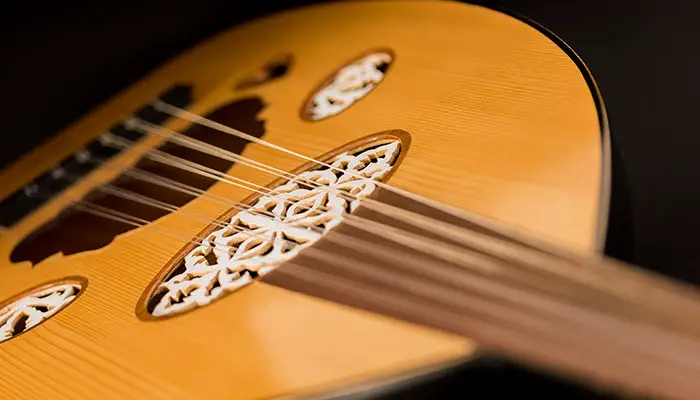The Truth About Learning the Lute – How Difficult Is It?
Folkstrings.com is reader-supported. When you buy through links on our site, we may earn a small commission.
You may be wondering should I learn to play the lute. Well, hopefully, this article will go some way in helping you.
The lute is a beautiful instrument that plays a beautiful melody.
Lutes are considered instruments of old that are still enjoyed today.
This gorgeous instrument features a long neck and a rounded body that is shaped like a halved egg.
Musicians play the lute solo, in duets, and large orchestras.
The lute is a stringed instrument that knows no bounds and it would take a lifetime and more to play all of the music that is available to lute musicians!
Table of Contents
- How Hard Is It to Learn the Lute?
- How Do You Tune a Lute?
- How Was the Lute Created?
- What’s the Difference Between a Lute and a Guitar?
- What’s the Difference Between a Lute and a Mandolin?
- Should I Learn to Play the Lute? – Conclusion
How Hard Is It to Learn the Lute?

One of the first questions people ask about the lute is, “Is it hard to play?”.
To answer this question, the lute is no more difficult to learn to play than other stringed instruments such as the guitar or violin.
If you want to learn an instrument of any kind, even the lute, you simply need to put your mind to it and get started.
Any instrument is going to take time to master. Some take to it right away, much as a duck takes to water, but some musicians struggle and end up giving up in the end.
The difficulty of learning the lute will depend upon your experience and the number of strings.
As stated, some lutes can have up to twenty-five strings, which makes them more difficult to play for some musicians.
Lutes are very fine instruments and must be played with care.
You just cannot strum the strings as aggressively as you would a guitar.
One of the biggest mistakes people make when picking up the lute is, they expect it to be a funny-shaped guitar, but this is not reality.
The lute is much more complex, and some are not even fretted.
Some musicians are concerned it will be difficult for them to read French tablature, but for most people, it is fairly straightforward.
Once you are familiar with reading French tablature, an entire world of lute music will open up for you.
How Do You Tune a Lute?
Before you can learn to play the lute, it has to be tuned properly.
Because a lute has many strings, musicians sometimes worry about being able to tune it correctly.
To tune a lute, you will find it easier if you place the end clasp in your lap, on your shoes, or a cloth on the floor, depending on the size of the instrument.
With the instrument facing you and the tuner nearby, where you can see the screen, you are more likely to tune the lute with precision.
Consider the following steps to ensure you know how to tune your lute.
1. Use an electronic tuner to match the pitch and temperament accurately.
2. Be sure to produce a coherent sound from each string, without sounding adjacent strings that could throw off the pitch.
3. Make sure you are accurately hearing the pitch when tuning by ear. If using an electronic tuner, it will notify you when the pitch is correct.
4. You will need to manipulate the pegs to reach the desired pitch. On some lutes, it is necessary to pull the peg out slightly, wind it slowly, and then push it back in at the same depth you pulled it out.
5. If your lute has frets, these may need to be adjusted as necessary.
How Was the Lute Created?

The lute has a vast history, dating back as far as the 13th century.
Throughout the Renaissance, lutes were beloved instruments.
Shakespeare was entranced by this ravishing instrument and often spoke of it in his works.
Although the lute was beloved in Europe, it was not born in this part of the world.
The lute gets both its name and shape from the Arabic ‘ud instrument.
‘Al ‘ud’ means, “The Wooden One”, and this instrument is still a big part of the Arabic music scene.
The lute made its way to Europe in the Middle Ages, likely brought over during the Crusades or through Spain or Sicily.
During the Medieval period, the lute only had five pairs of strings and was plucked using a quill plectrum.
Although this instrument created beautifully melodic music, the string setup and plectrum did not lend itself very well to solo play.
In the 15th century, changes came about that brought the lute into its own.
Musicians realized this instrument could be plucked with the fingers instead of using a plectrum.
A sixth pair of bass strings were added, giving the lute a better range of tones.
When the sixth course was added, changes were made to the body and neck of the lute.
The body was made more elongated and elegant, and a new tablature system was invented to notate the music of the lute.
At the end of the 16th century, the lute took on more changes.
First, the seventh course of strings was added, followed by an eighth and ninth.
Eventually, there were up to 25 pairs of strings. With so many strings, a second longer neck was often added to the lute.

For over 150 years, the lute became an instrument of choice and would fetch a high price, depending on its maker.
It is easy to see why this instrument is so appealing to so many musicians and music lovers alike.
· It is light and portable.
· The lute is much less expensive than many instruments.
· It harmonizes beautifully with other instruments.
· This instrument is very versatile.
· The lute is much easier to maintain than many instruments.
What’s the Difference Between a Lute and a Guitar?

The modern guitar and the lute share some attributes, yet they are very different.
Often, individuals are interested in how these two iconic instruments differ.
Understanding the differences between the two instruments can help students to determine which stringed instrument will bring them the most pleasure.
· The lute is much lighter than the guitar, even when the two instruments are similar in size.
· There is also a difference in the strings. Traditionally, lutes are strung with animal gut, nylgut (which is a synthetic animal gut), and nylon. Guitars are strung with steel or nylon strings.
· Because of the strings, lutes and guitars have distinct sounds. Lute strings produce a much crisper and brighter sound than the guitar.
· Obviously, there is also a difference in bodies. The halved egg shape of the lute is created by gluing strips of wood to the soundboard. Guitars have a flat back.
· Another difference between lutes and guitars is lutes are not as loud.
What’s the Difference Between a Lute and a Mandolin?
Although the lute and mandolin are both stringed instruments that are plucked, there are some key differences musicians should know before deciding which one to pick up.
On the surface, there are some similarities, but these instruments are built and played in unique ways.
· The number of strings on each instrument differs considerably. The mandolin has eight strings, and the lute can have fifteen to twenty-five.
· There are also playing differences. The lute is played much like the guitar, using the thumb to play higher notes. Modern mandolins are typically played with the vibration of a plectrum that allows for a sustained tremolo.
· Mandolins are typically reserved for folk, country, and bluegrass, whereas lutes are better suited for Celtic sounds, classical, and new age music.
· It is easier to find a mandolin for sale than it is a lute, and lutes are typically more expensive because they are so rare. It is important to practice care when purchasing any second-hand instruments because the necks can bow due to improper care.
· Another difference between these two instruments is size. Typically, lutes are much bigger than mandolins, even when they are on the smaller side. You can expect the average string length of a mandolin to be 300-335 mm and the string length of a lute to be 700-750 mm.
Should I Learn to Play the Lute? – Conclusion
If you are asking if you should learn how to play the lute, the answer is a resounding yes.
Lute music is some of the most beautiful in the world, and it speaks to musicians of all types and skill levels.
A lute is a fascinating instrument to play, and you should add it to your collection.
Although it has a learning curve and takes time to master, it is undoubtedly worth the effort.
If you have been considering the lute, now is a perfect time to get started.
Practice makes perfect, and you will soon be able to play this instrument with flair.
Author Profile
-
Daniel Johnstone is an English writer with a love for stringed instruments from around the world.
He shares his love for these instruments through his writing for folkstrings.com, a website dedicated to all things related to folk string music.
Daniel's passion for music started at a young age, and he has since become an accomplished musician, playing guitar, cavaco, and recently, the harp.
His dedication to learning and sharing his knowledge of stringed instruments is evident in his insightful and engaging blog posts. Whether you're a seasoned musician or a beginner, Daniel's writing is sure to inspire and entertain you.
When he's not playing music or writing, you can find Daniel exploring new instruments and seeking out new sounds to share with his readers.
Latest entries
 OcarinaApril 1, 2024Why Does My Ocarina Sound Bad? Tips for Improved Tone Quality
OcarinaApril 1, 2024Why Does My Ocarina Sound Bad? Tips for Improved Tone Quality ZitherMarch 30, 2024Who Are Some Famous Zither Instrument Players? Let’s Find Out!
ZitherMarch 30, 2024Who Are Some Famous Zither Instrument Players? Let’s Find Out! ZitherMarch 30, 2024Should I Learn the Zither? Exploring the Benefits of This Unique Instrument
ZitherMarch 30, 2024Should I Learn the Zither? Exploring the Benefits of This Unique Instrument ZitherMarch 30, 2024What is the History of the Zither: Tracing the Strings Through Time
ZitherMarch 30, 2024What is the History of the Zither: Tracing the Strings Through Time
Affiliates:
This post may contain affiliate links that at no additional cost to you, the site may earn a small commission. We only recommend products we would use ourselves and all opinions expressed on this site are our own.
Accuracy Advice:
While we strive to provide up-to-date and accurate information, the content in this article may not reflect the most current research or medical guidelines. We encourage readers to do further research and consult with professionals for more personalized advice.
Our Recommendations:
The products and services mentioned in any of our articles are recommended based on our independent research and personal experience. We are not sponsored by any company. We aim to suggest products and services we believe are of high quality and could be beneficial to our readers.


